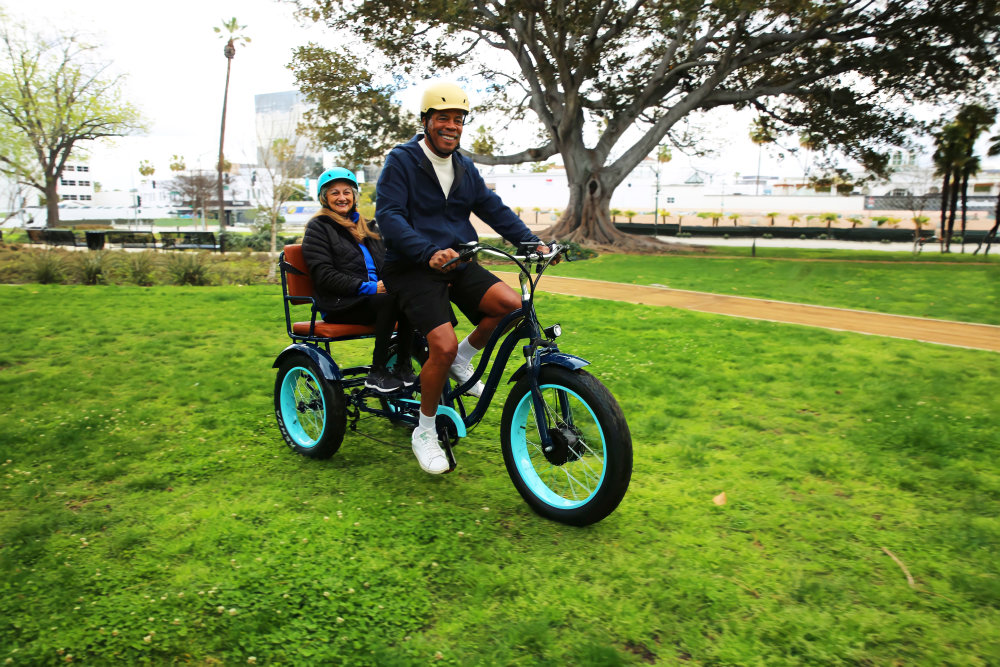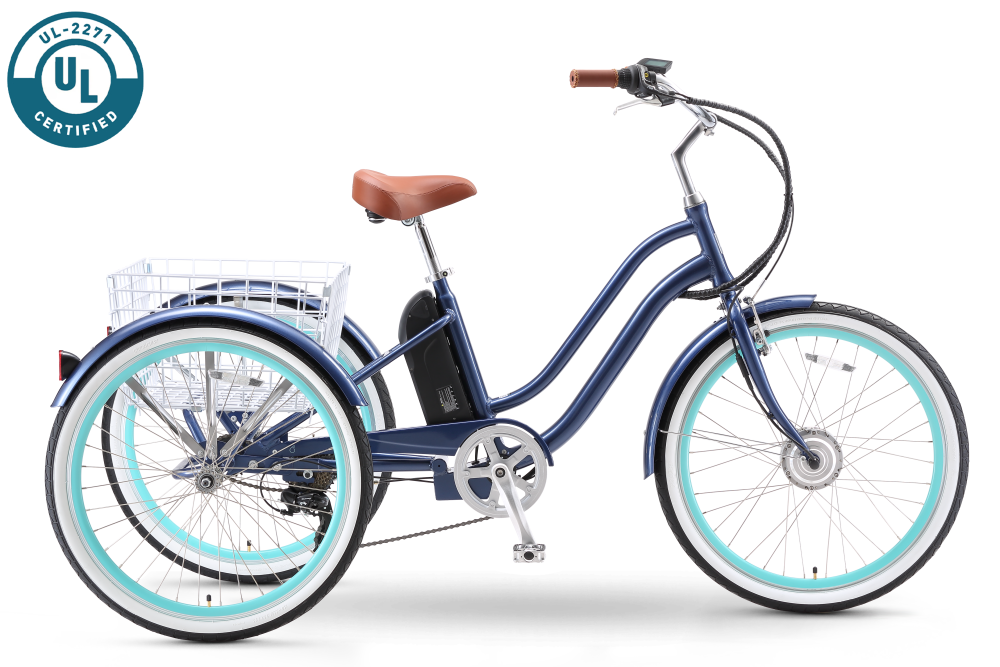E-Bikes & Bikes Customised to You
Steering a Two Wheel Bicycle vs a Tricycle (3 Wheel Bike): What's the Difference? Adult Trike Info
Dustin Gyger
Updated On: October 19, 2023
Steering a two-wheel bicycle versus steering a three-wheel bike, what's the difference? Stick around to find out. Hey everyone, I'm Dustin. I have nearly 20 years of experience in the bike and e-bike industry, and today we're going to talk about steering a two-wheel bike versus steering a three-wheel bike and what's the difference. Now, before I get into it, hit that subscribe button below, and stay in touch with us here at sixthreezero. Be the first to know about all the new content we're putting out, giveaways we're doing, and of course new product releases. One more thing, if you are in the market for a trike or electric trike, I've got three awesome trikes right here that are linked in the description below, the Easy Transit Folding Trike, the Rickshaw Trike for passengers and the Cruising EvryJourney Trike. Again, linked in the description below, also linked in the upper corner of the video here. So check them out. They are awesome. And you can find more videos about all these trikes on our YouTube channel.
All right, I've done hundreds of test rides with riders who are either riding a tricycle for the first time as an adult or a senior. And a lot of these riders have either been off of a bicycle for many, many years, like 10, 20, 30, 40 years, or they've biked a lot and now they're switching to a three-wheel bike because they feel more safe and more comfortable. And I see this a lot in the over 60 category. A lot of riders who were avid two-wheel cyclists for a long time just don't feel as confident with their balance. And so now they want to switch to three wheels, which is a great option, and especially in this day and age now with electric options, a three-wheel bike can go just as fast as a two-wheel bike and give you the added stability with the two wheels in the rear.
Now, one thing I see though is when a lot of riders get onto a three-wheel bike for the first time, they're surprised that it doesn't steer the same way as a two-wheel bike. So what's the difference? Well, the biggest difference is you've got two wheels in the back on a three-wheel bike and you've got two inline wheels on a regular bike. On a regular bike, the process of riding a two-wheel bike is more about the leaning of your body, the going with the bike, the swaying. And the turning is usually a gradual turn that happens with the lean of your body. So in combination with the turning of the wheel and the leaning of the body is what makes the bike turn.
If you were to come into a turn right on two wheels, let's say you're going to swoop around a street, you would come in and you would lean into the turn and go. And the bike stays upright because of the speed at which you're traveling. Now, taking that same turn on a three-wheel bike, totally different, leaning your body is not going to move the trike in any way, shape, or form. Now, there is an advantage to how you shift your body weight on a trike to ensure you keep both rear wheels on the ground, but it's not going to steer the trike in any way, shape, or form.
So I see it a lot with first-time test riders, they start to lean and they're like, "Why is the trike still going straight?" I say, "You've got to steer the wheel, steer the wheel, steer the wheel." And that's the difference between a trike and a bike. You have to drive the trike, you have to drive and steer like a car, and on a bike, it's more of a lean, more fluid motion. So it's a lot different actually between these two. What I find is that riders need to retrain their mind on how you operate a three-wheel bike. And once they do, it's very easy for them and very natural.
So just to reiterate, on a wheel bike, you're going to lean and turn. On a trike, leaning is going to do nothing for you. It's all about turning the handlebars. The other big difference on a trike, is because you have the two wheels in the back, you can turn this at almost a zero radius, right? So even at the most severe angle of a handlebar, I can go ahead and I can turn this trike like this right, and the trike would stay upright. You could never have your handlebars at this severe of an angle on a two-wheel bike and make that turn successfully. You wouldn't be able to go fast enough, and you would tip over. On a trike, you can turn these handlebars at whatever severe angle you choose, as long as you're able to still twist your body in that direction, and you'd be able to make that turn.
So that's one major difference you're going to be limited on what kind of turning radius you can make on a two-wheel bike because there's only so small of a circle you can make where you can keep the bike upright and also make that turn. Whereas on a trike, you can make very severe zero-radius turns and the two wheels will keep you balanced in the rear at all times.
Now, that's something also to remember a lot of people when they take turns on tricycles, take them very slow and they end up going very wide because they think in their mind that it's not going to balance. Now, I do advise taking turns slowly on tricycles because you want to make sure both of the rear wheels stay down and when you finish the turn, you can accelerate out of the turn on a tricycle. I don't recommend accelerating into the turn on a trike, whereas on a bike, you actually would, it'd be okay to accelerate into the turn because you want to keep the wheel spinning to keep the bike upright. It's the opposite on a trike. Slow down into the turn, and accelerate out of the turn. On bikes, it's no problem. You want to accelerate in and lean into that turn and go through it, that works. On a trike, I do not recommend that.
Now, if you're a very aggressive, experienced trike rider, you could shift your body weight and lean into the turn, but not for the reason of turning, for the reason of keeping the wheels down on the ground. Again, the lean will not move a trike. The turn of the wheel is what's going to turn and move the trike. And so back to what I was saying about taking the turns, a lot of people don't realize that you have to turn the wheel, so they end up taking very wide turns when they get out for their first trike ride. And I'm always yelling at them if I'm watching, I'm saying, "Turn the wheel, turn the wheel, turn the wheel." Because then when they start to turn, they're like, "Oh, it goes. I turn the wheel and it goes." And so it's that connection of how they're not getting that they're leaning is not turning the trike until they turn the wheel. Because when you rode a two-wheel bike and you leaned, the bike would move a lot more than a trike would. So it's a major difference.
So major difference number one, on the bike, you don't have to turn the handlebars as much as you do on a trike. On a trike, leaning will not turn the trike. On a two-wheel bike, leaning will help to assist the trike. The other thing I will say is on a three-wheel bike, you're always going to be balanced, right? On a two-wheel bike, you have to do the balancing. Now, what's interesting is that a lot of people on two-wheel bikes have been doing it for so long, they're so accustomed, that balancing has become second nature. And so it's interesting because when they don't have to balance on a trike, sometimes they feel more unstable, surprisingly, even though in reality you're more stable.
Now, the last thing I'll say is again, there is an art to getting familiar with riding a trike and how to come into the turns and how to lean into a turn to keep the wheels down and to go the correct pace through turns. It's very easy, it's very simple, I promise you'll get the hang of it. And if you want more info about how to ride a trike, we have videos on our YouTube channel. You can look up how to ride a trike. I've also got How to Ride an e-Trike on there, and we explain the turning and how to move through it.
After an hour or two of just testing, and practicing, you'll have it, no problem. For some people, it takes a little longer, again, to untrain their minds and get used to the differences between steering a two-wheel bike and a three-wheel bike. But it'll come, it'll happen. Don't be discouraged if the day you sit down for the first time doesn't come very easily. Remember, you didn't learn to ride a two-wheel bike in a day either. And so retraining your mind as an adult is going to be much more difficult than when you learn to ride a two-wheel bike with a fresh, clean slate, with no preconceived notions. You learned from scratch how to ride a two-wheel bike and your mind soaked it up. And even then, you didn't learn to do that overnight, right? It took a couple of weeks, a couple of months. Everybody moves at a different pace. So stick with it and don't be discouraged.
So that pretty much summarizes the differences between riding a two-wheel bike and a three-wheel bike. If you have any other questions at all, please comment below email us at theteam@sixthreezero.com or call us at (310) 982-2877. Don't forget, all three of these trikes are linked to the description below or linked in the upper corner. There'll also be a link at the end of the video. These are great options, different types of trikes here. You can also find more YouTube videos on our channel about all the different trikes we carry, the different use cases, and what is good for what type of rider. So check out all those videos as well.
And we have a 30-day test ride for your trike policy. If you don't love it in the first 30 days, send it back, no questions asked, no money out of your pocket. In addition to that, we are going to warranty everything for a year. If anything goes wrong in the first year, parts or labor will cover it to keep you up and riding. Lastly, we have a Facebook Pedalers group with thousands of members. Join the group, and connect with existing trike riders, and bike riders. Ask them questions in advance of purchasing so you can get comfortable buying a trike before you jump in. Then once you have yours, post in the group, and make friends. It's tons of fun. You can download our app, the Sixthreezero app on the app store, the Play Store, track your rides, and compete on the leaderboard. It's a lot of fun. So thanks for sticking around. And don't forget, it's your journey, your experience. Enjoy the rides.
Fit







